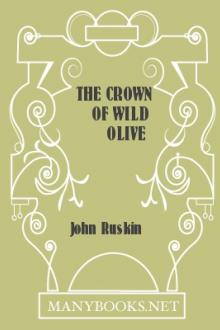Lectures on Landscape by John Ruskin (free ebook reader for android .TXT) 📖

- Author: John Ruskin
- Performer: -
Book online «Lectures on Landscape by John Ruskin (free ebook reader for android .TXT) 📖». Author John Ruskin

19. Here is the most ordinary component of a foreground for instance, a pleasantly colored stone. Any of its pure outlines are not only without beauty, but absolutely powerless to give you any notion of its character, although that character is in itself so interesting, that here Turner has made a picture of little more than a heap of such stones, with blue water to oppose their color. In consequence of these difficulties and insufficiencies, most landscape-painters have been tempted to neglect outline altogether, and think only of effects of light or color on masses more or less obscurely defined. They have thus gradually lost their sense of organic form, their precision of hand, and their respect for limiting law; in a word, for all the safeguards and severe dignities of their art. And landscape-painting has, therefore, more in consequence of this one error than of any other, become weak, frivolous, and justly despised.
20. Now, if any of you have chanced to notice at the end of my "Queen of the Air," my saying that in landscape Turner must be your only guide, you perhaps have thought I said so because of his great power in melting colors or in massing light and shade. Not so. I have always said he is the only great landscape-painter, and to be your only guide, because he is the only landscape-painter who can draw an outline.
His finished works perhaps appear to you more vague than any other master's: no man loses his outlines more constantly. You will be surprised to know that his frankness in losing depends on his certainty of finding if he chooses; and that, while all other landscape-painters study from Nature in shade or in color, Turner always sketched with the point.
"Always," of course, is a wide word. In your copying series I have put a sketch by Turner in color from Nature; some few others of the kind exist, in the National Gallery and elsewhere. But, as a rule, from his boyhood to the last day of his life, he sketched only with the fine pencil point, and always the outline, more if he had time, but at least the outline, of every scene that interested him; and in general, outline so subtle and elaborate as to be inexhaustible in examination and uncopiable for delicacy.
Here is a sketch of an English park scene which represents the average character of a study from Nature by Turner; and here the sketch from Nature of Dumblane Abbey for the Liber Studiorum, which shows you what he took from Nature, when he had time only to get what was most precious to him.
21. The first thing, therefore, you have to learn in landscape, is to outline; and therefore we must now know precisely what an outline is, how it ought to be represented; and this it will be right to define in quite general terms applicable to all subjects.
We saw in the fifth Lecture[5] that every visible thing consisted of spaces of color, terminated either by sharp or gradated limits. Whenever they are sharp, the line of separation, followed by the point of your drawing instrument, is the proper outline of your subject, whether it represents the limits of flat spaces or of solid forms.
22. For instance, here is a drawing by Holbein of a lady in a dark dress, with bars of black velvet round her arm. Her form is seen everywhere defined against the light by a perfectly sharp linear limit which Holbein can accurately draw with his pen; the patches of velvet are also distinguished from the rest of her dress by a linear limit, which he follows with his pen just as decisively. Here, therefore, is your first great law. Wherever you see one space of color distinguished from another by a sharp limit, you are to draw that limit firmly; and that is your outline.
23. Also, observe that as your representing this limit by a dark line is a conventionalism, and just as much a conventionalism when the line is subtle as when it is thick, the great masters accept and declare that conventionalism with perfect frankness, and use bold and decisive outline, if any.
Also, observe, that though, when you are master of your art, you may modify your outline by making it dark in some parts, light in others, and even sometimes thick and sometimes slender, a scientifically accurate outline is perfectly equal throughout; and in your first practice I wish you to use always a pen with a blunt point, which will make no hair stroke under any conditions. So that using black ink and only one movement of the pen, not returning to thicken your line, you shall either have your line there, or not there; and that you may not be able to gradate or change it, in any way or degree whatsoever.
24. Now the first question respecting it is: what place is your thick line to have with respect to the limit which it represents—outside of it, or inside, or over it? Theoretically, it is to be over it; the true limit falling all the way along the center of your thick line. The contest of Apelles with Protogenes consisted in striking this true limit within each other's lines, more and more finely. And you may always consider your pen line as representing the first incision for sculpture, the true limit being the sharp center of the incision.
But, practically, when you are outlining a light object defined against a dark one, the line must go outside of it; and when a dark object against a light one, inside of it.
In this drawing of Holbein's, the hand being seen against the light, the outline goes inside the contour of the fingers.
25. Secondly. And this is of great importance. It will happen constantly that forms are entirely distinct from each other and separated by true limits, which are yet invisible, or nearly so, to the eye. I place, for instance, one of these eggs in front of the other, and probably to most of you the separation in the light is indiscernible. Is it then to be outlined? In practically combining outline with accomplished light and shade there are cases of this kind in which the outline may with advantage, or even must for truth of effect, be omitted. But the facts of the solid form are of so vital importance, and the perfect command of them so necessary to the dignity and intelligibility of the work, that the greatest artists, even for their finished drawings, like to limit every solid form by a fine line, whether its contour be visible to the eye or not.
26. An outline thus perfectly made with absolute decision, and with a wash of one color above it, is the most masterly of all methods of light and shade study, with limited time, when the forms of the objects to be drawn are clear and unaffected by mist. But without any wash of color, such an outline is the most valuable of all means for obtaining such memoranda of any scene as may explain to another person, or record for yourself, what is most important in its features.
27. Choose, then, a subject that interests you; and so far as failure of time or materials compels you to finish one part, or express one character, rather than another, of course dwell on the features that interest you most. But beyond this, forget, or even somewhat repress yourself, and make it your first object to give a true idea of the place to other people. You are not to endeavor to express your own feelings about it; if anything, err on the side of concealing them. What is best is not to think of yourself at all, but to state as plainly and simply as you can the whole truth of the thing. What you think unimportant in it may to another person be the most touching part of it: what you think beautiful may be in truth commonplace and of small value. Quietly complete each part to the best of your power, endeavoring to maintain a steady and dutiful energy, and the tranquil pleasure of a workman.
II. LIGHT AND SHADE.28. In my last Lecture I laid before you evidence that the greatness of the master whom I wished you to follow as your only guide in landscape depended primarily on his studying from Nature always with the point; that is to say, in pencil or pen outline. To-day I wish to show you that his preëminence depends secondarily on his perfect rendering of form and distance by light and shade, before he admits a thought of color.
I say "before" however—observe carefully—only with reference to the construction of any given picture, not with reference to the order in which he learnt his mechanical processes. From the beginning, he worked out of doors with the point, but indoors with the brush; and attains perfect skill in washing flat color long before he attains anything like skill in delineation of form.
29. Here, for instance, is a drawing, when he was twelve or thirteen years old, of Dover Castle and the Dover Coach; in which the future love of mystery is exhibited by his studiously showing the way in which the dust rises about the wheels; and an interest in drunken sailors, which materially affected his marine studies, shown not less in the occupants of the hind seat. But what I want you to observe is that, though the trees, coach, horses, and sailors are drawn as any schoolboy would draw them, the sky is washed in so smoothly that few water-color painters of our day would lightly accept a challenge to match it.
And, therefore, it is, among many other reasons, that I put the brush into your hands from the first, and try you with a wash in lampblack, before you enter my working class. But, as regards the composition of his picture, the drawing is always first with Turner, the color second.
30. Drawing: that is to say, the expression by gradation of light, either of form or space. Again I thus give you a statement wholly adverse to the vulgar opinion of him. You will find that statement early in the first volume of "Modern Painters," and repeated now through all my works these twenty-five years, in vain. Nobody will believe that the main virtue of Turner is in his drawing. I say "the main virtue of Turner." Splendid though he be as a colorist, he is not unrivaled in color; nay, in some qualities of color he has been far surpassed by the Venetians. But no one has ever touched him in exquisiteness of gradation; and no one in landscape in perfect rendering of organic form.
31. I showed you in this drawing, at last Lecture, how truly he had





Comments (0)